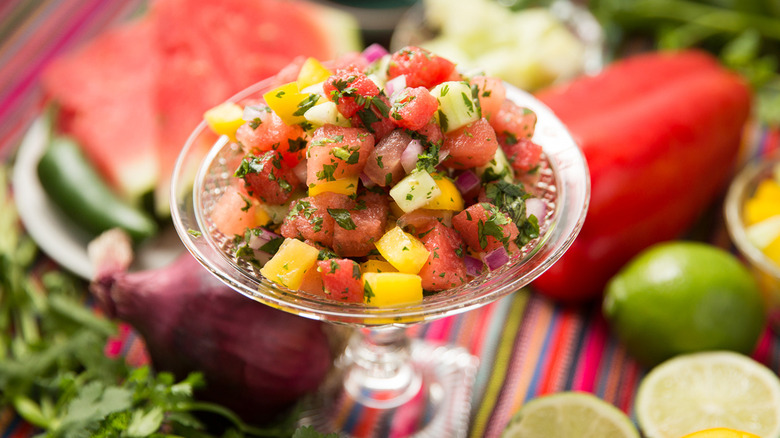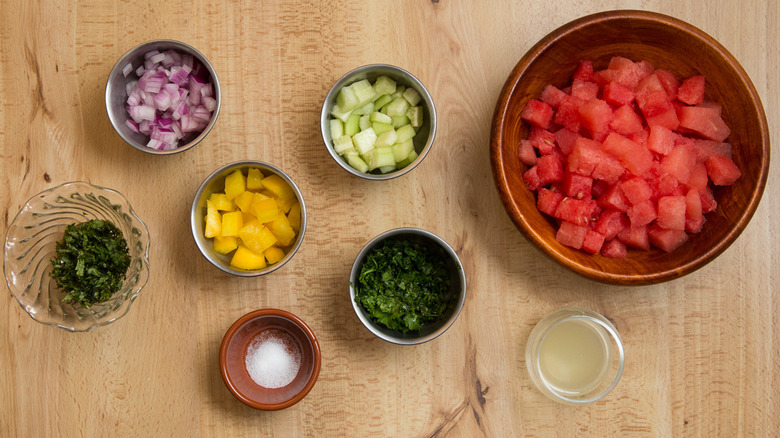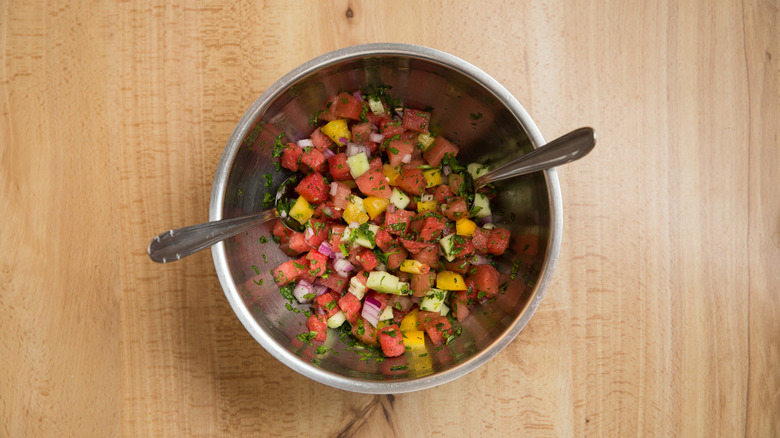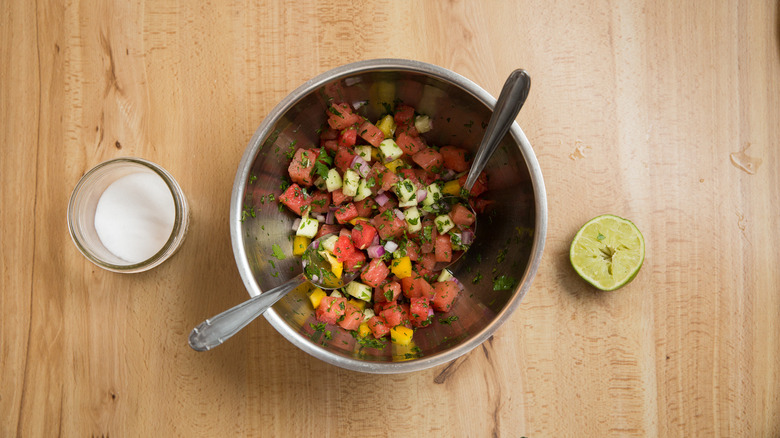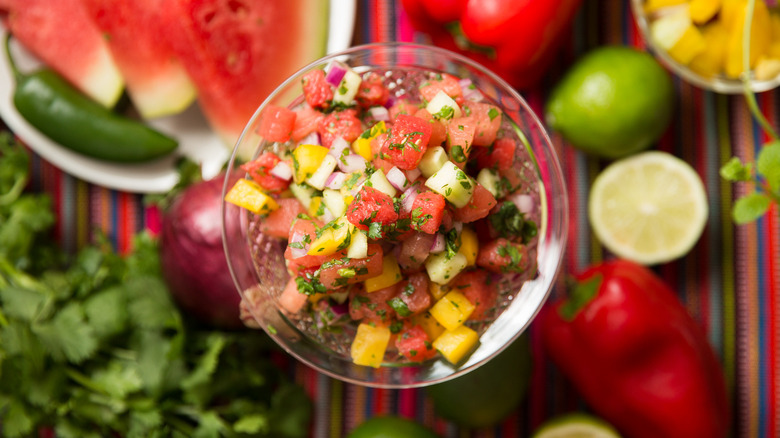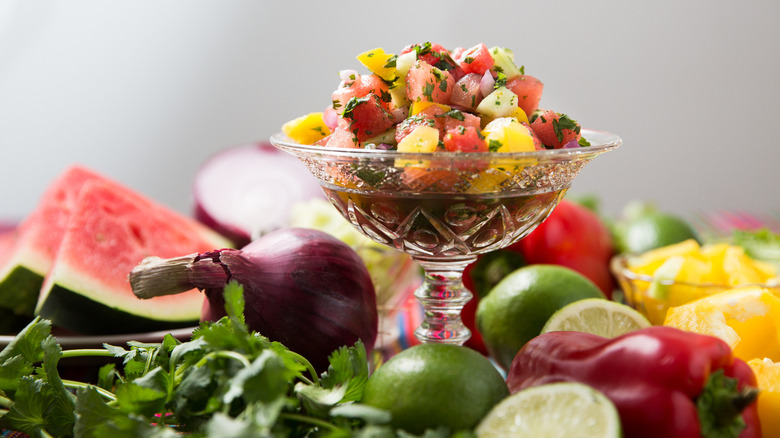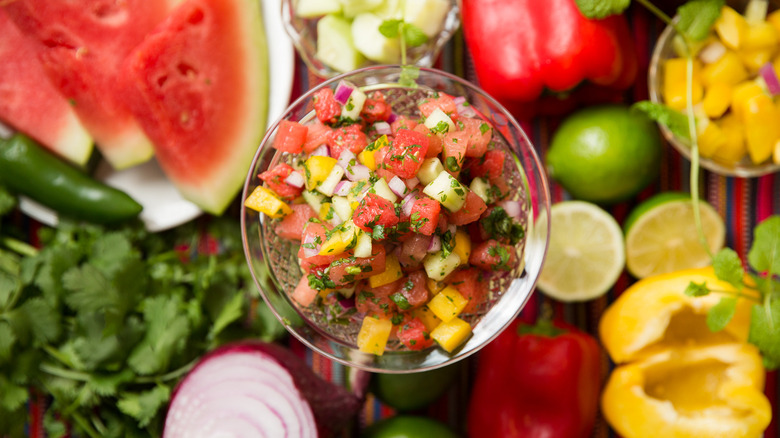Refreshing Watermelon Salsa Recipe
Salsa is one of the most popular condiments on American supermarket shelves; it experienced a popularity boom during the second half of the 1980s, even beating ketchup in number of sales by 1991. The ancient origins of salsa go back thousands of years — the Aztecs and Mayans in pre-Columbian Mexico made sauces with tomatillos or tomatoes, chiles, and other ingredients like squash seeds. Although they would be unrecognizable to these ancient cooks, the variety of unique salsas enjoyed in the U.S. today is nevertheless impressive. Making salsa with fruit is just one variation.
Recipe developer Michelle Bottalico has created a recipe for watermelon salsa that is perfect for the summer months when this popular fruit is in season. It contains not only refreshing and naturally sweet watermelon but also juicy vegetables like bell pepper and cucumber. It gets a bright boost from fresh mint, cilantro, and lime juice. If you want to up the heat factor, you can add a finely diced jalapeño.
This salsa is delicious when scooped up with tortilla chips, but that's not the only way to serve it. Use it to top tacos, burritos, and grilled fish or meats, add it to scrambled eggs, spread it on baked potatoes, or incorporate it in salads made with vegetables or grains like quinoa. For a unique presentation, serve this refreshing salsa inside hollowed-out mini watermelon halves at your next summer cookout.
Gather your watermelon salsa ingredients
For this recipe, you will need a ripe watermelon. You can choose a regular or seedless watermelon according to your preference. Buying a prepackaged quarter or half of a watermelon at the supermarket is an option if you don't need the whole thing, as watermelons can be quite large. The vegetables you'll need are yellow bell pepper and cucumber. You can use red bell pepper if yellow isn't available, but the yellow color contrasts pleasantly with the rosy watermelon. Finally, grab some red onion, cilantro, mint, lime juice, and salt for flavor.
Step 1: Toss the ingredients
Add all of the ingredients to a large bowl and toss gently until evenly mixed.
Step 2: Taste and adjust if necessary
Taste and adjust for salt and lime juice if desired.
Serve the refreshing watermelon salsa
Serve immediately or refrigerate until ready to serve.
Refreshing Watermelon Salsa Recipe
Juicy, refreshing, and flavorful, fresh watermelon salsa comes together in under 5 minutes and is perfect for dipping or to jazz up all your summer meals.
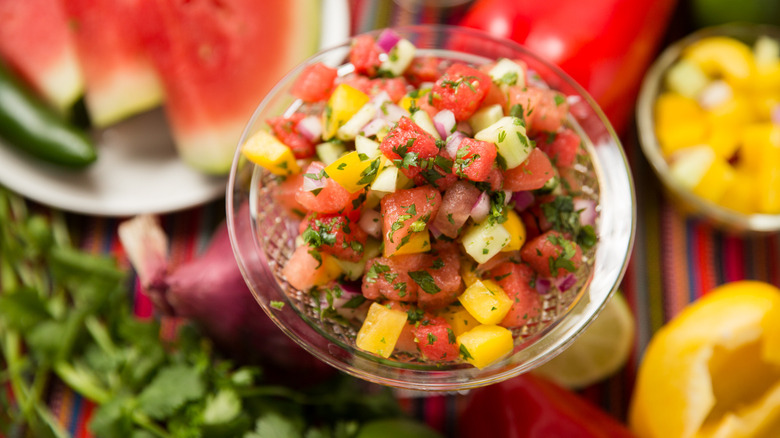
Ingredients
- 2 cups seeded and diced ripe watermelon
- ¼ cup diced yellow bell pepper
- ¼ cup peeled and diced cucumber
- ¼ cup diced red onion
- 3 tablespoons finely chopped cilantro
- 2 tablespoons finely chopped mint
- 1 tablespoon lime juice
- ¼ teaspoon salt
Optional Ingredients
- 1 small jalapeño, seeded and diced, or to taste
Directions
- Add all of the ingredients to a large bowl and toss gently until evenly mixed.
- Taste and adjust for salt and lime juice if desired.
- Serve immediately or refrigerate until ready to serve.
Nutrition
| Calories per Serving | 21 |
| Total Fat | 0.1 g |
| Saturated Fat | 0.0 g |
| Trans Fat | 0.0 g |
| Cholesterol | 0.0 mg |
| Total Carbohydrates | 5.2 g |
| Dietary Fiber | 0.5 g |
| Total Sugars | 3.5 g |
| Sodium | 98.8 mg |
| Protein | 0.5 g |
How can I choose and cut a watermelon to make salsa?
A ripe watermelon is best for this recipe. It may seem difficult to know when a watermelon is ripe, but there are a few telltale signs that can help you spot one. First, take a look at the pale spot on the skin without the distinctive green markings. This is the area that was in contact with the ground. A ripe watermelon will have a yellow or orange spot instead of a white one. Next, a moist green stem means the fruit hasn't ripened. Choose one with a dried brown stem instead. Another clue is the brownish webbing on the skin — more webbing means it's riper. Finally, you may have heard of the tapping technique for watermelons – the fruit should sound hollow when you knock on it.
Unless you're saving the hollowed watermelon rind to serve the salsa in, there is no special method for cutting a watermelon to make salsa. If you are serving it in the rind, choose a mini watermelon, cut it in half, and carefully slice the flesh in both directions to create cubes, being careful to leave about half an inch intact around the edge. Then spoon out the chunks and dice them. Otherwise, quarter a watermelon and cut thin triangular wedges before cutting off the rind and dicing the flesh. Many people prefer seedless watermelon, but you can easily remove the seeds from the thin slices if you have a regular watermelon.
How can I customize watermelon salsa?
If you'd like to substitute ingredients in this watermelon salsa recipe, you have many options. First, you could add diced tomato to give the dish a more traditional color and feel. Chopped avocado is another option that would add creaminess as well as its mild, distinctive flavor. If you don't have red onion, shallot is an excellent alternative. Some people prefer their salsa spicy. In that case, you can add extra jalapeño, leave the seeds in, or add any other kinds of hot chiles you prefer. Lemon juice would work just as well as lime juice here, and as far as herbs, other fresh herbs like basil, parsley, and lemongrass can be used instead of or in combination with the mint and cilantro the recipe calls for.
Since this is a fruit salsa, it's possible to go in the other direction and instead of adding veggies add your favorite fruits and make an all-fruit version. Some ideas for fruits that work well are strawberries, mango, peaches, and pineapple. If they are available, consider an unconventional fruit to try in your salsa – cape gooseberries. These small, mild fruits are in the tomato family and have a tangy kick. If you make an all-fruit version, you can leave the salt out and, if desired, drizzle on a little honey or agave to kick the sweetness up a notch.
